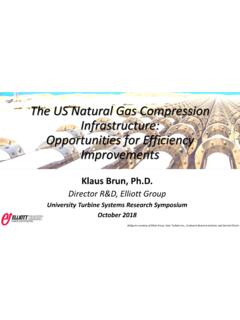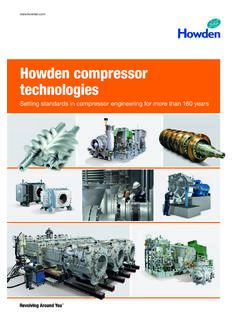Transcription of Mechanical Design of Turbojet Engines – An Introduction
1 Mechanical Design of TurbomachineryMechanical Design of Turbojet Engines An IntroductionReference: AERO0015-1 - Mechanical Design OF TURBOMACHINERY - 5 ECTS - GOLINVAL University of Liege (Belgium)2 Content1. Mechanical challenges of Turbojet technology2. Dynamic analysis of industrial rotors3. Structural dynamics of blades and discs4. ConclusionMechanical Design of Turbojet Engines3 Evolution of Turbojet Engines to the technology level of today new concepts or technological breakthroughs are rare; advancements are rather due to evolutionary improvements of the Design To achieve good performances, parallel research and development effort were undertaken in areas such as in aerodynamics, aerothermics, acoustics, combustion process, mechanics,metallurgy, manufacturing, ..Aim of the courseStudy the Mechanical aspectsof the of Turbojet technology4 Overall efficiency of a jet propulsion engineoverallthermalpropulsive = Thermal efficiencyPropulsive efficiencyChallenges of Turbojet technologyAir intakeCompressorTurbineCombustorExhaustP rinciples of jet propulsion501234eThermal efficiency 3124e0 TemperatureEntropyThermodynamic cycle031thermalTT = The thermal efficiency is defined as the ratio of the net power out of the engine to the rate of thermal energy available from the to the T-s diagram of an ideal Turbojet engine, the thermal efficiency simplifies toChallenges of Turbojet technology6thrustflight velocitytotal power outputexit velocityPropulsive efficiency The propulsive efficiency is defined as the ratio of the useful power output (the product of thrust and flight velocity.)
2 V0 ) to the total power output (rate of change of the kinetic energy of gases through the engine). This simplifies to0021propulsiveouteFVWVV ==+ Challenges of Turbojet technology7To progress to the performance capabilities of today, two goals were (and still are) being pursued:1. Increase the thermodynamic cycle efficiency by increasing the compressor pressure ratio. 2. Increase the ratio of power-output to engine weight by increasing the turbine inlet temperatureChallenges of Turbojet technologyWhat are the consequences of these goals on the Mechanical Design ?8 Goal n 1 - Increasing of the compressor pressure ratio (r) Mechanical challenges of Turbojet technologyIncreasing r variable geometry to adapt the compressor behavior to various regimesTrend in compressor pressure ratios30:1 to about 40:1200020:1 to about 25:11950 to 1960 About 10:1 Early 19503:1 to about 6:1 Late 1930 to 1940 compressor pressure ratioCalendar years9 Solution n 1: concept of variable stator blades Design of reliable airflow control systems Prevention of air leakage at the pivots of the vanes at high pressures (temperatures).
3 Variable stator vanesHP compressorMechanical challenges of Turbojet technology10 Solution n 2: concept of multiple rotors (r ~ 20:1 - 30:1)Example of a dual-rotor configurationFanHPCHPTLPTCFM56 Advantages Selection of optimal speeds for the HP and LP stages. Reduction of the number of compressor stages. Cooling air is more easily taken between the LP and HP rotors. The starting of the engine is easier as only the HP rotor needs to be challenges of Turbojet technology11 Rolls-Royce RB211 engineMechanical challenges of Turbojet technology12 Mechanical challenges Analysis of the dynamic behavior of multiple-rotor systems and prediction of critical speeds. Design of discsMechanical challenges of Turbojet technologyStructural dynamicists and Mechanical engineers may have opposite requirements optimisation process13 To place the first critical speeds above the range of operational speeds, the LP shaft diameter should be as high as of opposite requirementsMechanical challenges of Turbojet technology 2 (or even 3) coaxial rotors require to bore the HP discs to allow passing the LP shaft the stress level doubles (hole) and increases with the bore radius the LP shaft diameter should be as small as pressure turbine shaftHigh pressure turbine disc14 Depending on the types of applications, different development goals may be flight(military Engines )Maximum thrust is sought by increasing the exit velocity (at theexpense of fuel economy)
4 And decreasing the engine inlet diameter ( of the aerodynamic drag)Challenges of Turbojet technologyExampleSNECMA M88 military engine (used on the RAFALE airplane)15 Subsonic flight(commercial Engines )A low thrust specific fuel consumption is sought by increasing the propulsive efficiency the principle is to accelerate a larger mass of air to a lower of Turbojet technologySolution: principle of the by-pass engine (called turbofan)16 Solution: principle of the by-pass engine (called turbofan)Challenges of Turbojet technologyDrawback: the frontal area of the engine is quite large more drag and more weight result17 Challenges of Turbojet technologyTrend in thrust specific fuel consumptionYearPropfanSingle-pool axial flow turbojetAdvanced technology (high by-pass ratio)Twin-spool front fan turbojetTwin-spool by-pass turbojet18 Development of high-bypass ratio turbofansMain technological challenge: Mechanical resistance of fan blades (without penalizing mass).
5 Improvement of structural materials such as titanium alloys. Design of shrouded fan blades with a high length-to-chord aspect ratio or of large-chord fan blades with honeycomb core. Knowledge of the dynamics of rotors stiffened by high gyroscopiccouples and submitted to large out of balance forces ( fan blade failure). Fan blade-off and containment analysis methods ( blade loss). Use of Foreign Object Damage criteria ( bird or ice impact on fan, ingestion of water, sand, volcanic ashes,..). Mechanical challenges of Turbojet technology19 New concept:high by-pass engine wide chord fan blade the weight is maintained at a low level by fabricating the blade from skins of titanium incorporating a honeycomb coreProp-fan conceptWide chord fan blade constructionThis configuration is still in an experimental stateContra-rotating prop-fanMechanical challenges of Turbojet technology20To progress to the performance capabilities of today, two goals were (and still are) being pursued:1.
6 Increase the thermodynamic cycle efficiency by increasing the compressor pressure ratio. 2. Increase the ratio of power-output to engine weight by increasing the turbine inlet temperatureChallenges of Turbojet technologyWhat are the consequences of these goals on the Mechanical Design ?21 Goal n 2 - Increasing the turbine temperature capabilityChallenges of Turbojet technologyTrend in turbine inlet temperaturesTurbine inlet temperatureMilitaryCommercialYear C22 Main technological challenge: the HP turbine temperature is conditioned by the combustion chamber outlet combustion chamberMechanical challenges of Turbojet technologyStress distribution in a structural element of the combustion chamber23In early Turbojet Engines :solid blades the maximum admissible temperature was directly related to improvement of structural materials (Tmax~ 1100 C)From 1960-70.
7 Development of early air-cooled turbine blades hollow blades internal cooling of blades (casting using the lost wax technique) Mechanical challenges of Turbojet technology24 Lost wax processMechanical challenges of Turbojet technologyHP nozzle guide vane coolingHP turbine blade coolingFilm cooling holesInternal and film cooling25 Today:single crystal castingMechanical challenges of Turbojet technology26 Mechanical challenges of Turbojet technologyTime (hrs)Single crystal bladesComparison of turbine blade life properties(fixed temperature and stress levels)Single crystal bladesConventionally cast bladeDirectionally solidified bladesElongation (%)**Fracture27 Dynamic analysis of industrial rotors28 1D-model (beam elements): the most used for pilot-studies. 2D-model (plane or axisymmetric shell elements): practical interest for projects.
8 3D-model (volume elements): used for detailed elementAxisymmetricshell elementVolume elementNodesDynamic analysis of industrial rotorsThe Finite Element Methodis commonly used in ()()()(),,t+ + + =Mq Cq Kq f q qg Damping matrix of localized elementsGyroscopic matrixStructural damping matrix()S+ + CGCAS tiffness matrix of localized elementsStructural stiffness matrixMatrix of circulatory forces()SAS+ + KCKA vector of nonlinear forces (associated to interaction elements)Mass matrixDynamic analysis of industrial rotorsEquations of motionvector of excitation forces30 Type of analysis Stability analysis and determination of critical speeds (Campbell diagram). Forced response to harmonic excitation. Forced response to transient excitation (crossing of critical speeds).Dynamic analysis of industrial rotors()()0S+ ++ =MqGq KKqA ()()()()St+ + + =Mq Cq KKq gA 31 The critical speeds should placed outside two zones: 50 % and [75% - 110%] of the nominal mission profile for a civil aircraftTake-off 100 % NCruiseStep climbContinued cruiseDiversionHoldLanding 50 % NClimbDescent 75 % N 90 to 95 % NStability analysis32 Twin-spool front fan turbo-jet (high by-pass ratio)Take-off thrust of 11 340 daNThe CFM 56-5 jet engine (Airbus A320, A 340)Example of analysis33 Low-pressure (LP) rotor(9 nodes, 5 beam elements, 9 discs)Casings(15 nodes, 4 beam elements, 4 discs, 6 supplementary mass elements)High-pressure (HP) rotor(7 nodes, 3 beam elements, 7 discs)()1 258750.
9 = +HPLPrpmThe CFM 56-5 jet engine (Airbus A320, A 340)Schematic model of the jet engineBearingsBearingsIntershaft bearing341000 2000 3000 4000 5000 RPMC ampbell diagramMode-shapes at 5000 rpm200 100 Hz11602490347042605720HP = = LP Hz208032803730 The CFM 56-5 jet engine (Airbus A320, A 340)35 Response to mass unbalance on LP rotor (point A) 2000 3000 4000 50001000 2000 3000 4000 5000At point AAt point B LP LP11602490347042605720116024903470426057 20 The CFM 56-5 jet engine (Airbus A320, A 340)36 Structural dynamics of blades and discs37 Vibration phenomena are the main cause of failureof compressor blades and to predict: natural frequencies ( to identify critical speeds); mode-shapes ( to establish vulnerability to vibrate and locations of maximum stresses); damping levels ( severity of resonance); response levels ( fatigue susceptibility); stability ( vulnerability to flutter).
10 Structural dynamics of blades and discs38()()()2CC,t,,,++ + = MqGq K qFg qq Geometric stiffness matrixCentrifugal mass matrixVector of static centrifugal forcesMass matrixVector of external forces()2 SgCC+ KK MStructural stiffness matrixEquations of motionGyroscopic matrixDynamic analysis methods for practical blades39 Type of analysis and solution methodsStatic analysis (in order to determine the stress distribution due to the centrifugal forces)()()()22 SgCCC+ = +KK MqFgThis equation is nonlinear, since Cis unknown a priori the solution needs an iterative process, such as the Newton-Raphson analysis methods for practical blades40 Dynamic analysis()0C,+ =Mq K q As the Coriolis effects can be neglected (this is usually so for radial blades), the equations of motion reduce towhere K has been determined by a preliminary static solution of this equation for different values of allows to construct the Campbell analysis methods for practical blades41 Campbell diagrams (Natural frequencies vs.)


